
Subscribe & stay up-to-date with ASF

For the adult Atlantic salmon preparing to return to their native rivers, and for the smolts readying to leave their rivers, the Covid-19 pandemic means nothing. But for the rest of us, it is a time where we would love to have a crystal ball to peer a few months into the future, but unfortunately that cannot happen.
Being the second year of the pandemic, we do have a better idea on how to plan, even as the nature of the virus threat shifts, seemingly by day and by week. Almost certainly in 2021 we are going to have regular Atlantic salmon angling seasons. But the questions remain as to who can connect this time with the salmon rivers so important to our lives, and to our culture’s heritage, and economy.
Vaccinations will make a big improvement in the potential for travel, both within the country and internationally. But so far governments here, in the U.S., and elsewhere have not made decisions on how the rules will change.
At the moment international borders are largely closed to recreational angling, and even hard for researchers to cross. Within Canada it seems the new strains of virus are causing more lockdowns, most notably in Quebec and Ontario. Air travel is reduced, with fewer flights, and in some cases medium-sized airports without service at all.
Things may be very different by mid-summer, but no promises are being given by anyone. Meanwhile, we can give updates on the Atlantic salmon and some views of outfitters and others intimately involved with the coming salmon migration.
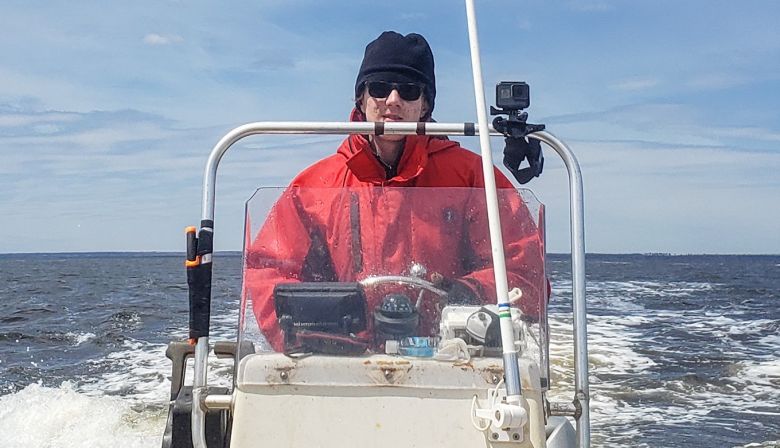
Jonathan Carr, ASF’s Vice-president of Research and Environment, gave an update yesterday morning of the work planned this spring.
“It is full steam ahead this year with the acoustic tagging,” said Carr. “We will be smolt tagging in the Restigouche, Cascapedia, Northwest Miramichi, and Southwest Miramichi. We have an early spring this year, but the smolt tagging will take place early to late May.
“As part of the tracking at sea, the acoustic receivers will be going out into the Baie des Chaleurs and in the Miramichi system and estuary in mid-April.”
Kelt tagging is back with a full program.
“Through the Environmental Studies Research Program we are assisting many partners with both acoustic and satellite “pop-off” tagging of kelts in the Cascapedia, Restigouche and Miramichi this year..
While water levels are high at the moment, there seems little chance of disastrous floods interfering with the program. And with low ice levels at sea, both in the Gulf of St. Lawrence and Labrador Sea, the results could be very positive.
“As to the Strait of Belle Isle lines of receivers, they are not deployed until late June, but everything seems on track with that research as well.”
It should also be noted that other programs of acoustic tagging are taking place, for example in Nova Scotia rivers. We will give updates as information
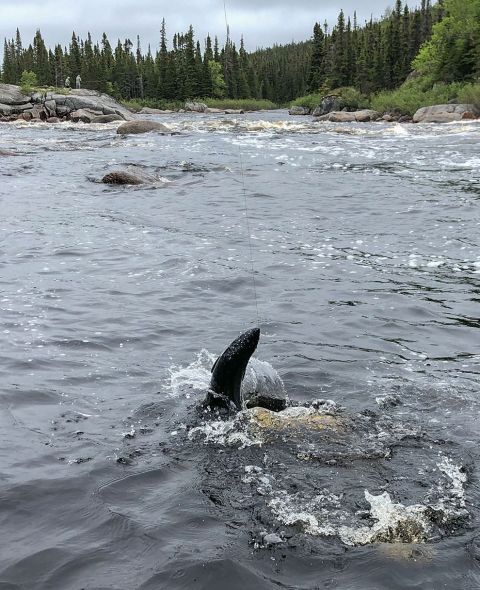
We contacted a few camp managers and outfitters, getting a pre-season reading on their views.
Jacques Heroux, Manager of Larry’s Gulch Camp on the Restigouche:
“We are running with the standard covid-19 protocol developed last year. We will have eight guests at a time, with one per boat and one per cabin. Personal distance of 6 ft. will be maintained. It went very well last year, and until the situation changes, we are going with this,” said Heroux.
“We are full for the entire 2021 season, all the guests from within the Atlantic provinces bubble that appears likely to be implemented again,” he said. Naturally we are hoping for good water and a good run of Atlantic salmon.”
Debbie Norton, owner of Upper Oxbow Adventures, on the Northwest Miramichi:
“The ice moved out on Tuesday, Apr. 6, and the river will be in terrific shape for Apr. 15,” says Norton.
“I am hoping the international border opens in July. Of course it depends on the vaccine and beating the virus, but we’ve got to come up with a plan to deal with those vaccinated and arriving at Canada’s and New Brunswick’s border.”
“The federal government needs to come to grips with the criteria that will be required to open the border for salmon anglers and other visitors.
The Canada and U.S. governments should be issuing a picture id card with vaccination details. We need more than a photocopied piece of paper that can be made up by anyone.”
“Everyone here should have a vaccine shot by June, and that will hopefully make a difference. Resident anglers will continue to fish, but they are not part of the full economic equation for the rivers. We truly need to have that system that allows the border to be open.”
Mike Crosby who owns lodges in Labrador on the Hawke and Flowers rivers:
“There has been less snow than normal this winter. I am looking forward to an early year,” he says. This year, on the Hawke we had problem getting supplies into the camp, with a low snowpack making it tough for snowmobiles.”
“We don’t have a plan for either foreign or Canadians to come to fish this year, and I have nothing to tell my guests at this moment. With the airlines cancelling runs into Goose Bay we can only hope there will be changes ahead.
(Editor’s note: At mid-week PAL regional airline announced regular flights from Fredericton to Goose Bay for the first time, and perhaps this will be of interest to some wishing to visit Labrador rivers.)
“A number of tough decisions will need to be made,” says Crosby, “It is difficult to run a business, and customers don’t know if they can travel.
“I will need to decide when to tell people whether they can come or not. This is not a good situation.”
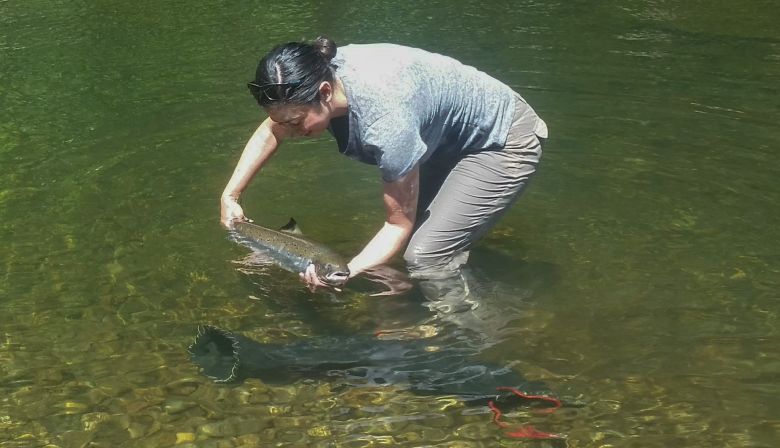
John Burrows, ASF Director for U.S. Operations, put together an overview of the upcoming activity by the partners and ASF on Maine’s salmon rivers:
Penobscot River – No smolt trapping this year
Sandy River, on the Kennebec system – 2021 will be the first year that Maine DMR smolt traps the Sandy. Gear is being deployed at the end of this week and they hope to start running the traps early next week.
Narraguagus River, a Downeast salmon river – Maine DMR will be deploying the smolt traps on Friday and Monday at Route 9 and Little Falls, respectfully. The plan is to start fishing on Monday.
East Machias River – Maine DMR will be assisting the Downeast Salmon Federation (DSF) with deployment of traps at some point in the next couple of weeks. DSF will be staffing them on a daily basis.

In 2020 Covid-19 meant most of the recreational angling was left to residents. And while the early part of the season generated good reports of fish, extreme heat and low water levels brought the good reports to a screeching halt.
Don Ivany, ASF director of programs in Newfoundland and Labrador, has been following closely the assessment data and news generated by DFO as we get closer to the 2021 season.
“On March 17, 2021, DFO held their Annual Salmonid Advisory Meeting for the Island portion of the province and provided an update on the 2020 salmon returns to monitored rivers here.
“Out of the fourteen rivers monitored on the Island in 2020, DFO determined that seven rivers were in the critical zone, two were in the cautious zone, and five were in the healthy zone.
On March 18, 2021, DFO held their Annual Salmonid Advisory Meeting for Labrador and provided a further update for this area. Out of the three rivers monitored in Labrador in 2021, DFO determined that two rivers were in the cautious zone (Muddy Bay Brook, and Southwest Brook), and one river was in the healthy zone (English River).
Putting this together, of the 17 rivers monitored in NL in 2020, seven were in the critical zone, three were in the cautious zone, and seven were in the healthy zone. Not exactly the good news everyone had been hoping to hear.
What’s even more concerning is that DFO’s Science Division reported six of the monitored rivers in 2020 saw greater than a 30 per cent decline from the previous five-year average returns.
They also reported that returns to two rivers on the south coast of Newfoundland continue to decline, and that the Conne River and Little River are approaching local extinction.
Conne River had an annual return of 10,000 fish two decades ago but only had 120 fish return this past year, while Little River had just four wild fish return this year.
These two wild salmon rivers are located near the heart of the open-net-pen aquaculture industry on Newfoundland’s south coast.
Based on these results, the majority of groups represented on DFO’s Salmonid Advisory Committee’s this year recommended that DFO take a precautionary approach for the 2021 recreational salmon fishing season, until there are signs of stock recovery.
On another note, the island portion of the province experienced a very mild winter and far less snowfall than normal.
This coupled with the fact that spring broke early in 2021, with much of the snow already melted. Wecould be in for more low water and warm water temperatures unless we get a wet summer.
Temperatures were a little warmer than usual in Labrador this winter and sea ice conditions were very light compared to other years. When sea ice conditions in Labrador are light, salmon returns to our rivers tend to be better, so keep your fingers crossed.
DFO is currently in the process of trying to make sense of all the recommendations they received this year, in preparation of the Salmon Management Plan for the 2021 season. If previous experience means anything, its anyone’s guess as to what the new management plan will contain.
Will DFO again ignore all advice as they have done in the past and simply roll over the previous years plan, or will they follow their own precautionary principle and the advice of their advisory committees?
The management plan is not expected to be released until some time in May and the recreational salmon fishery traditionally opens on June 1 for the island, and June 15 for Labrador.
While it’s still too early to tell what impact Covid protocols will have on the ability of non-resident anglers to visit our province this season, as of today, things are looking more promising than they did last year at this time and we look forward to seeing those anglers back on our rivers to renew old friendships.
Charles Cusson, ASF’s Director of Programs in Quebec, examined the results of the Quebec assessment of Atlantic salmon and angling for 2020.
The 2020 year was remarkable in Quebec Atlantic salmon science history as despite a lethal pandemic, the scientists were able to gather good data on the fish migrations and angler harvests. The Covid-19 disrupted travel and recreational use, but it would seem that anglers, mostly from Quebec, were able to connect with the salmon.
In addition, overall it was a good year for the Atlantic salmon returns, and fingers crossed, there should be a good hatch of new fry this year as a result, at least for a large selection of the river populations. We will really not know for certain for another five years, but there is hope there.
Meanwhile this year the volatility of new Covid-19 strains seems likely to affect the first part of the season at least. With solid progress in vaccination, conceivably there could be easier travel rules by the last half of the season – but we will need to wait and see.
Bilan Report Released
Quebec’s Ministère des Forêts, de la Faune et des Parcs (MFFP) has released its report on 2020 Atlantic salmon returns and angling in the province. ASF staff have poured over the numbers and peered between the lines to bring you the highlights. 2020 represents the first half of the 10-year plan.
Thanks to efforts by FQSA (Fédération Québécoise pour le saumon atlantique), 2020 was very busy despite the pandemic and the lack of non-resident anglers. 67,809 rod days were sold compared to 69,086 in 2019.
While anglers in Quebec can purchase a license that allows them to keep 3 grilse and 1 large salmon, live release licenses continue to be the fastest growing category. In 2020, total licence sales remained stable with a total of 16,017 compared to 16,832 in 2019.
In 2020, returns were counted on 38 of Quebec’s 112 salmon rivers. On those monitored rivers, 30 291 adult salmon and 8,703 grilse were counted for a total of 38,991. For large salmon, fish over 63-centimeters that spend two or more winters at sea, the count is up by 8,000 from 2019.
A major contributing factor of the increase in large fish can be attributed to the agreement signed in 2018 with the people of Greenland.
In Quebec, anglers can catch and keep large salmon and grilse. It is the only province to allow the retention of large salmon, and along with Newfoundland and Labrador is one of just two provinces where people can keep grilse.
Last year, anglers in Quebec harvested 907 large salmon and 3,477 grilse. By comparison 9,769 fish were counted as released, likely a minimum estimate as anglers are not required to report when they let a fish go.
Here is a snapshot on how well some rivers did in 2020 to reach optimal targets during the spawning period:
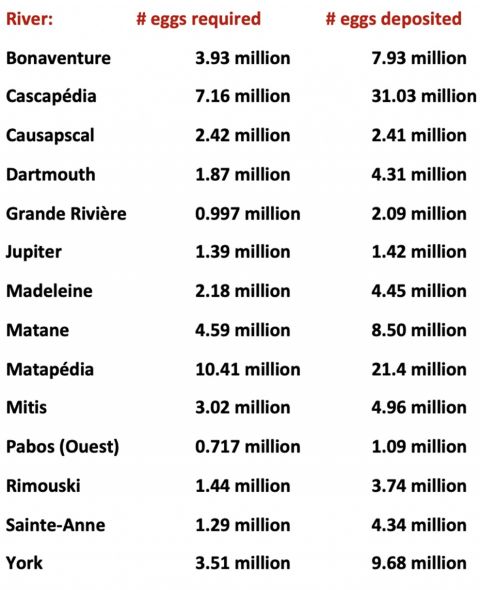
Thirteen rivers out of 38 exceeded their optimal spawning targets.
The harvest of large salmon in Quebec is closely watched under the provinces 10-year salmon management plan introduced in 2016. On monitored rivers, minus a few exceptions, no big spawners can be taken by anglers until a mid-season review is conducted and scientists are confident that enough fish have already entered the river to meet optimal spawning targets.
On rivers that are not monitored and not exempt from the management plan, only grilse can be harvested by anglers and, in some cases, live-release only rules are in effect.
Beginning in 2018, Quebec took further measures to limit the take of large salmon by reducing the number of tags issued with each license. In previous years anglers received seven tags good for grilse or large salmon. That number has been reduced to four, with only a single tag valid for fish over 63-centimeters. The result has been a significant reduction in the number of large salmon harvested by anglers.
For the full report on 2020 salmon fishing in Quebec visit:
https://mffp.gouv.qc.ca/nos-publications/bilan-exploitation-saumon-2020
Also, the Quebec Management Plan (English)
https://mffp.gouv.qc.ca/our-publications/atlantic-salmon-management-plan-2016-2026/?lang=en
To learn more about Quebec’s unique system for salmon angling, and find fishing opportunities, visit: https://www.saumonquebec.com/en
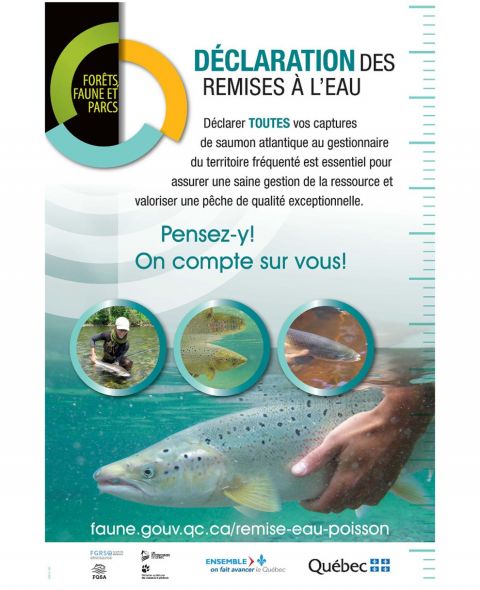
Le ministère des Forêts, de la Faune et des Parcs (MFFP) du Québec a récemment publié son bilan saumon pour la saison 2020. La saison dernière représente la 5e année du plan de gestion saumon au Québec, en vigueur depuis 2016.
Grâce aux efforts de la FQSA (Fédération québécoise pour le saumon atlantique), l’année 2020 a été très achalandée en dépit de la pandémie et le manque de pêcheurs non-résidents. 67 809 jours pêches ont été vendus, comparativement à 69 086 en 2019.
Les pêcheurs sportifs du Québec peuvent acheter un permis qui leur permet de récolter 3 madeleineaux et 1 grand saumon. En 2020, les ventes de permis totales (toutes catégories confondues) sont restées stables avec un total de 16 017 contre 16 832 en 2019.
Pendant la saison dernière, 38 991 poissons (30 291 saumons adultes et 8,703 madeleineaux) furent dénombrés sur 38 des 75 rivières où la pêche est permise. Pour les grands saumons, par rapport à 2019, les montaisons sont en hausse de 8 177 saumons additionnels.
L’accord conclu en 2018 entre la FSA, ses partenaires et le Groenland ne peut pas être ignoré comme un des facteurs principaux qui expliquent l’augmentation des retours de grands saumons.
L’an dernier, les pêcheurs du Québec ont récolté 907 grands saumons et 3 477 madeleineaux. Cependant, 9 769 poissons, soit 69% (8 149 grands saumons et 1 620 madeleineaux) des 14 163 captures totales ont été déclarées « remis à l’eau ». La déclaration d’une remise à l’eau n’est pas obligatoire, mais très importante pour les gestionnaires pour qu’ils puissent calculer un taux de succès précis.
La récolte de grands saumons au Québec est étroitement surveillée dans le cadre du plan de gestion du saumon de la province introduit en 2016. À quelques exceptions près, aucun grand saumon ne peut être récolté par les pêcheurs jusqu’à ce qu’un décompte de mi-saison soit effectué et que les scientifiques sont convaincus que suffisamment de saumons ont déjà migré dans la rivière pour atteindre les seuils de conservation optimale.
Depuis 2018, le Québec a entrepris d’autres mesures pour limiter la capture de grands saumons en réduisant le nombre d’étiquettes émises avec un permis annuel. Au cours des années précédentes, les pêcheurs recevaient sept étiquettes pour les madeleineaux et/ou les grands saumons. Le résultat de cette mesure a causé une réduction significative du nombre de grands saumons récoltés par les pêcheurs sportifs.
Voici un aperçu des résultats de la période de frai en 2020 en ce qui a trait l’atteinte du seuil de conservation optimal:
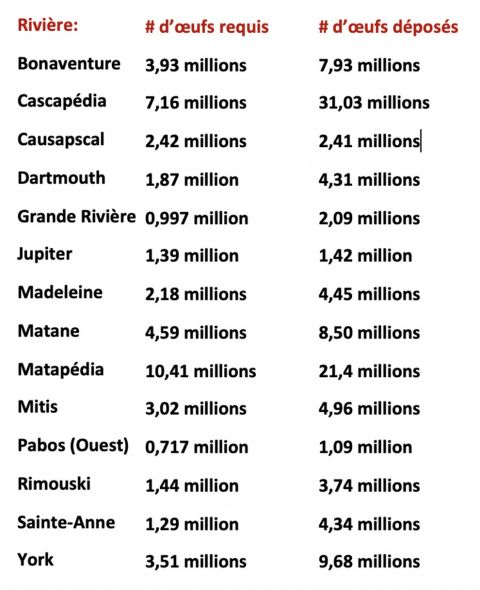
Les 13 rivières mentionnées ci-haut (sur les 38) ont atteint et/ou surpassé leurs seuils de conservation optimaux.
Pour accéder au rapport complet sur la pêche au saumon au Québec en 2020, visitez:
https://mffp.gouv.qc.ca/nos-publications/bilan-exploitation-saumon-2020
https://mffp.gouv.qc.ca/la-faune/plans-de-gestion/saumon-atlantique/
Pour en savoir plus sur le système unique de pêche au saumon au Québec et trouver des possibilités de pêche, visitez:
The new bridge, and eventual removal of the Petitcodiac gates in NB is underway, as of this week.
Edmund Redfield gives an overview of what is happening, as it relates to the river:
https://youtu.be/8ztoZGBoxwg
For more on fish handling and the science behind live release check out the Keep Fish Wet website:
We need your help to keep the restoration of wild Atlantic salmon going.
To explore ways of gift planning and to join ASF’s Royal Wulff Society,
please click here